I cannot escape the Western. It’s as a part of me as my own flesh and blood.
I’ve been fascinated with Westerns and Cowboy fiction for as long as I can remember. When I was a young boy living in deep south Texas I would go across the road to my grandfather’s house and there he’d be in the living room, tv on, watching the Encore Western channel. As the name implies it broadcasted nothing but Western and Cowboy movies or television shows. I watched the singing cowboys of Gene Autrey and Roy Rogers, the violent ballads of Peckinpah, and even modern westerns like The Assassination of Jesse James by the Coward Robert Ford.
These were tales of good and evil, justice and revenge, of people trying to navigate the challenges of a world changing faster than they can comprehend. They’re timeless stories offering everything from the worst that mankind has to offer to triumphs of human kindness. There are timeless characters to be admired, reviled or even at times pitied. As I grew I continued my exploration into the genre that vexed me as a youngster. I watched Spaghetti Westerns: Sergio Leone’s Dollars Trilogy, and like many I was captivated by The Man with No Name. I read Cormac McCarthy’s Border Trilogy which offers a counter to the trope of Mexico being the last bastion of freedom in a west becoming less wild and Blood Meridian, a novel exploring the horrific realities of the west.
The more I watched and read the more enthralled I became, but I also began to notice a pattern. Mexican characters portrayed as either easily enraged violent thugs or ineffectual drunkards. Native portrayals ranging from noble savages to barbaric warriors. Honorable Confederate characters with no qualms over their support of a slave state. Union soldiers portrayed as carpetbaggers and other such Lost Cause sentiments; indeed very few movies painted the Union or their soldiers in a fair light until the Western heyday had sunset. Revisionist westerns have attempted to reconcile the realities of the genre and how it frames a reality that didn’t exist for the many non-white and indigenous people of America, but to this day both I and the genre continue to grapple with these elements.
Enter Deadlands, a tabletop role-playing game that attempts to blend the Western genre with supernatural horror and a little bit of steampunk to taste. The setting is the Weird West, an alternate history United States where the Civil War dragged on due to the machinations of The Reckoners, a Four Horseman analogue responsible for all the supernatural terror.
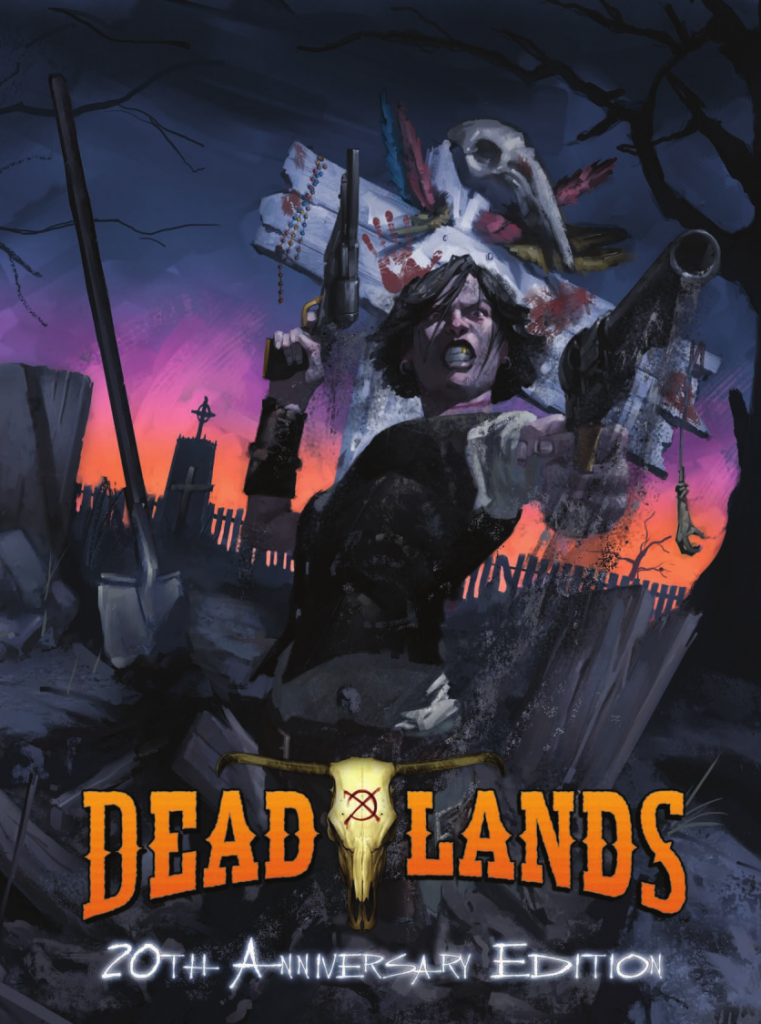
“Classic” Deadlands, created by Shane Lacy Hensley, was a standalone ttrpg with unique and flavorful mechanics for both character generation and actual play. Instead of rolling for attributes or spending preordained character points players would instead draw from a standard 54 card poker deck (yes, jokers too) and the resulting draws would define your Traits.
In addition to playing cards and your traditional polyhedrals it utilized a set of white, red and blue poker chips referred to as “Fate Chips”. Fate chips were drawn from the Fate Pot—a pile or hat—at the beginning of each session and could be used on certain in-game bonuses such as the prevention of damage. Players who were playing a Huckster character, Deadland’s rambling gambling spellcasting class, drew five cards from the deck to assemble the best possible poker hand which determined whether the spell succeeds as well as how powerful it is.
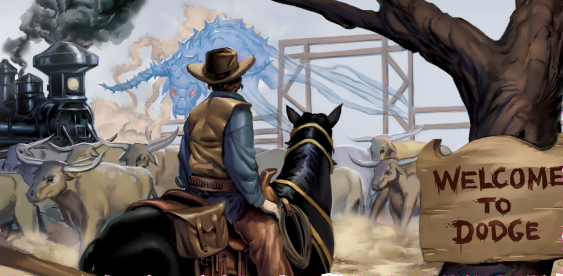
Classic Deadlands was a system that had a lot of heart and panache. The style oozes through the pages and the dime novel inspired art really pulls you into the setting. All that style and heart does not come without a price, however, as it is a rather cumbersome system to run. The cards, fate chips, and spellcasting subsystems all slow the game. The modern incantation, Deadlands: Weird West uses the Savage Worlds: Adventure Edition ruleset as its mechanical chassis, a generic system also created by Shane Lacy Hensley whose ruleset originated from a miniatures game set in the Deadlands universe called The Great Rail Wars that was then expanded into the Savage Worlds system we see today.
Fate Chips are back in the form of Bennies with similar functions including soaking damage. Unlike the original Fate Chips, players are granted 3 bennies per session with the chance to receive more as rewards for good roleplay. Initiative is no longer rolled; instead it’s determined by a deck of playing cards referred to in the Savage Worlds: Adventure Edition core rulebook as the Action Deck.
“Fast Furious and Fun” was the original tagline for Savage Worlds and it’s a design principal that has been maintained to Adventure Edition. Unfortunately it only hits the mark on the first two and not with any regularity. I often found my time with Deadlands: The Weird West to be rather frustrating both for myself as the GM and for my players. While Dramatic Tasks and Chases worked as advertised, combat often did not hit its stated goal of being fast paced and dynamic, and the character progression and the swinginess of the system did not inspire much enthusiasm from my players.
In the few combats I ran from the Dime Novel Adventure, combat would get bogged down. The swingy nature of the dice lead to a lot of whiffs and grazes from the players while an opposition haymaker attack led to one of the PCs to be Shaken, a status we as a table learned to loathe. Shaken is one of three damage effets. When the damage roll is equal to or greater than the target’s Toughness they become Shakened allowing them only to perform free actions on their turn until they succeed on a spirit roll, itself a free action. This loss of action on the most common result on the damage roll can really drag the speed of combat down as well as generally being an unfun mechanic. No one wants to sit around doing nothing on their turn player or GM.
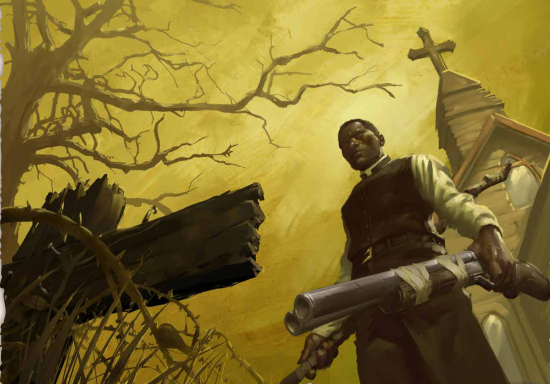
Progression wise both my players and I found the increasing of dice size when improving traits to feel unsatisfying in actual play. The system’s exploding dice mechanics means that the higher your trait die is, the less likely they explode on a roll and it never feels as if you’re becoming more competent when raising an attribute or skill either. With progressively larger dice your ceiling is raised—you’re allowed to succeed harder—but your floor remains the same. Characters are defined by their Edges and Edges end up being the most satisfying advancements in Deadlands: The Weird West but even those stumble. Many of the cooler and more flavorful Edges are locked behind Trait requirements and higher experience tiers and for Deadlands specifically it lead to character creation and advancement to feel rather flat. Who wants to wait to “Fan the Hammer”, the iconic gunslinger move of rapidly slamming down on your revolver’s hammer to mow down your enemies?
The rules for dueling was one bright spot, managing to emulate the cinematic tension of movie western duels. Duels Consist of Three rounds. Players don’t immediately attack; first the GM deals a card to each participant plus any from they might receive from their edges. Tensions mount as normally non-direct combat options like Intimidating, Taunting, or eyeing a weakness in your opponent’s draw emulate the back and forth camera cuts and lingering shots of our gunslinger’s eyes or trigger hands in a Leone movie. The final round is where the lead starts flying and the bodies start dropping. Neither ‘slinger is allowed to defend against these attacks because in the Weird West you play for blood.
In this instance The Weird West goes against its system’s tagline and in doing so makes the dueling experience all the more entertaining. While that’s great for duels, it also leaves me conflicted. Classic Deadlands is a product of its time and too clunky for me to run on most Virtual Tabletops but nails the setting, while The Weird West is far easier to run, especially with the robust Foundry VTT System provided by PEG, but in the aim mechanical simplification much of the theming is lost it doesn’t make for a more fun system to play or GM. Like with the genre it embodies, I remain hung up on playing Deadlands. The setting has its grips in me, but the systems are a challenge.
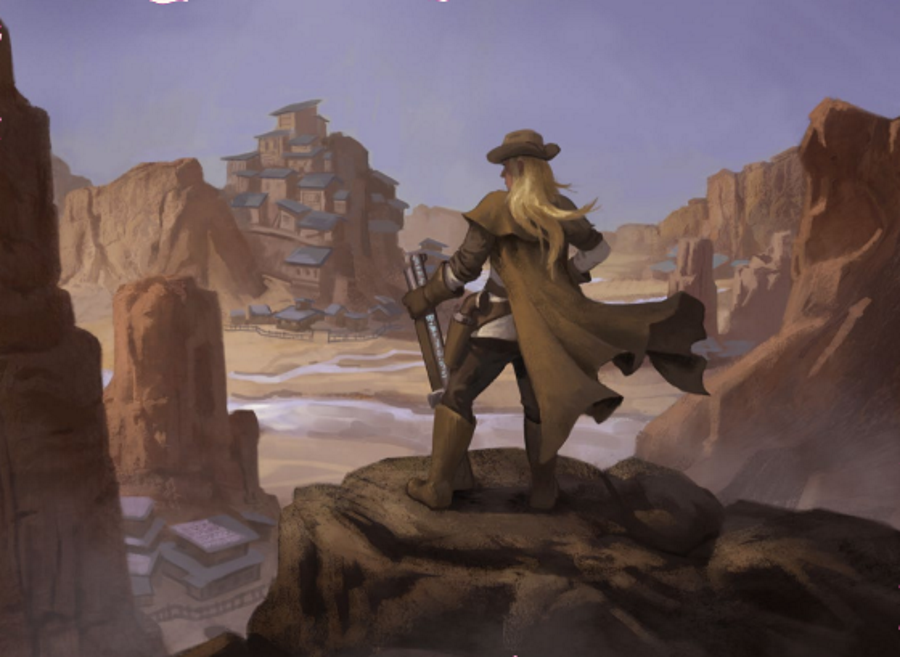
The setting of Deadlands, an alternate history American West, doesn’t diverge from our timeline until 1863 when which a group of Native Americans from a number of different tribes lead by the Sioux shaman Raven conducted a ritual in an effort to drive away the white settlers and in doing so opened a gate between the Hunting Grounds: a spirit world home to the Four Horsemen-like Reckoners and the malevolent manitou. At the conclusion of the Battle of Gettysburg the dead began to rise and attack former friend and foe alike.
This was the first action of The Reckoners on their quest to bring about an apocalypse. Since then they’ve gone further: undead gunslingers stalk the west alongside mythical creatures like vampires, werewolves, jackalopes, and chupacabras. Holy men and women were given divine gifts from their god allowing them to perform miracles and strike back at these evil creatures. Those who consider themselves to be more into games of chance than piety are granted powers by gambling parts of their soul against a spirit’s will. and then there’s Shamans: Native American holy men and women who draw their magical abilities from the spirits of nature.
 Credit: Pinnacle Entertainment Group
Credit: Pinnacle Entertainment Group
Out west the calamitous Great Quake of 1868, which saw most of California sink into the sea, created The Great Maze and revealed a new superfuel called Ghost Rock. It’s eerie name comes from the wail it produces when burned. This Infernal ore led to incredible advances in the scientific field allowing such Mad Scientist types to create devices once thought impossible. That’s the brief summary. There’s still a lot I’m leaving out like:
- The Great Rail wars between various Rail Barrons looking to be the sole company who builds the Union’s coast-to-coast railroad.
- The Mormon State of Deseret coming into being during the chaos of the Reckoning’s impact on the Civil War.
- The two Independent Native American states of the Sioux Nation and Coyote Confederation also came into being during this time.
- And much more.
In Deadlands YOU can be the High Plains Drifter; the revenant gunslinger back from the dead seeking revenge. Or maybe delivering sermons and smiting foul creatures empowered by your faith as The Preacher is more our style. You could even be a Doc Holliday-esque gambler who’s card up their sleeve is the sorcery they weave by dealing with the devil himself, always one step ahead of his opponents but riding that razor’s edge everytime he pushes his luck too hard.
Speaking of old Doc; in the Deadlands world he’s the first Hexslinger: a huckster who learned how to imbue his weapons with magic by carving runes onto his favorite piece. The good Doctor would go on to pass down these techniques to his friends and acolytes through the dime novels “The Adventures of Doc Holliday”. This is what I love about Deadlands; at its best Deadlands is a hodgepodge of the western, supernatural horror, and steampunk genres; veritable gumbo of pulp fiction.
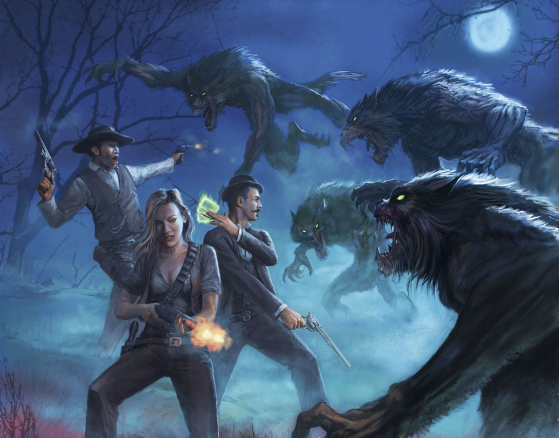
It is not always at its best, unfortunately. Deadlands shares many problems with the genre from which it draws most heavily from. Native portrayals are still quite tropey—one of the setting’s biggest villains is the shaman Raven who’s ritual caused all the evil stuff to pour out of the Hunting Grounds. The heavy use of the Algonquin word “Manitou” to refer to exclusively evil spirits when in actuality it refers to spirits of all kinds feels rather tone deaf.
The biggest elephant in the room is naturally the Lost Cause sentiments that were featured prominently in previous books. In Deadlands The Confederacy never really died; between the extended war and the rising dead the Civil War didn’t quite end. The result was a Cold War between the Union and Confederacy. While there’s nothing inherently wrong about using the Confederacy in an Alt-History setting, especially as villains, The Confederacy in Deadlands was often not portrayed in such a light.
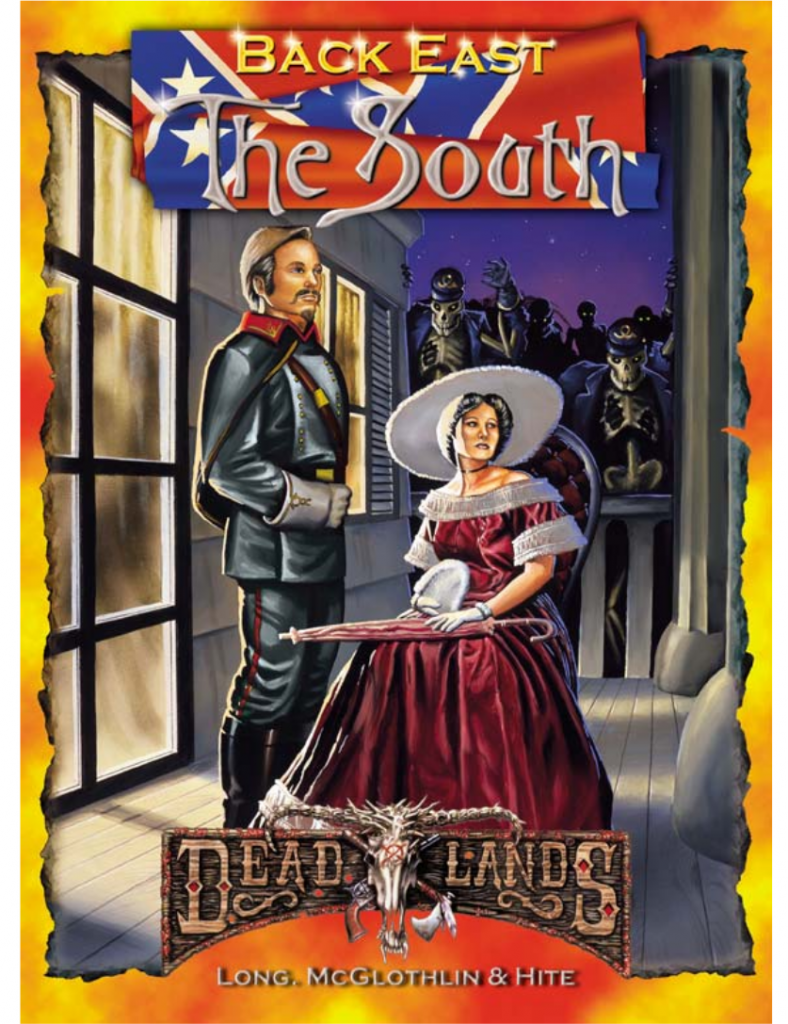
The worst examples of this Lost Cause rhetoric is from the infamous Back East: The South sourcebook. It’s a book that at its best is a misguided attempt to write the Confederacy— whose sole existence was to uphold the institution of slavery—as a Post-Racial state in order for the setting to be more inclusive. At its worst it’s Neo-Confederate apologia trash. Much of the book is written in a way that robs The Union of any moral high ground in order to paint the South in a better light than it deserves. The most egregious example being The South freeing slaves before the Union and the Union only doing so as a response to Confederate Manumission.
This sort of writing wasn’t exclusive to The South sourcebook, it infested nearly all of Deadlands. Nathan Bedford Forrest, first grand wizard of the KKK, is described as having a “Cursed Sabre” which of course was responsible for his heinous actions, and The Last Sons Plot Point in Deadlands: Reloaded involves the Posse receiving aid from the ghost of Confederate General Robert E. Lee.
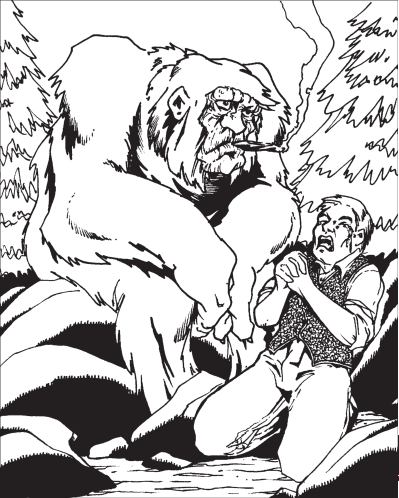
Deadlands: The Weird West does away with the biggest hurdle of the setting. The South loses and the Confederacy is dead. It took much longer in the Deadlands world than in ours but they were defeated. I support this retcon wholeheartedly, as too much of Deadlands lore felt like Confederate apologia. This is a massive step to combat that. Unfortunately, even with the rewritten lore there’s still one sticking point that more directly impacts me: the portrayal of the Texas Rangers. The Rangers have been rolled into the Territorial Rangers in the current Deadlands timeline and includes law dogs from the other 7 Territories: Arizona, California, Idaho, Montana, New Mexico, Washington, Wyoming, and Alaska.
I live in Texas and have done so my entire life. I’m not just a Texan I am Latino, a Tejano. Like all Texans and Western fans I grew up hearing and seeing and reading about the mythical Texas Rangers. Lonesome Dove, Walker Texas Ranger, The Lone Ranger; these perpetuate the myth of Texas Rangers as these heroic larger than life characters who were not just heroes but true heroes. The reality is far from the myth. The saying goes “Every Texas Ranger has Mexican blood. It’s on his boots.”
The Rangers hunted escaped slaves, murdered Mexicans in cold blood, fought for the Confederacy, performed night rides, and lynched. They were not heroes. Although this is just a game with an alt-history setting where undead cowpokes and sentient tumbleweeds exist alongside Appalachian giants and skunk apes, the setting itself is still based on real history. These sorts of portrayals hamper my enjoyment of the setting.
This is an eternal aspect of the minority condition in the USA. We fall in love with the same media as everyone around us, and then suddenly it delivers a punch to the gut made all the more painful by a callous sort of near-obliviousness. I feel so strongly about these portrayals because I really love a lot of what the setting has to offer and I do believe that it can improve. It’s already shown that it can. I certainly don’t think that creator Shane Hensley is a bad person, in fact I think the opposite (the author behind Back East: The South however is a different story). Hensley’s response to those complaining of the big Confederacy retcon is what fuels my optimism for Deadlands’ future as a setting.
Deadlands: The Weird West is the premier Western ttrpg on the market. Its colorful blend of the Western, Supernatural Horror, and Steampunk genres offer a game like no other. The Savage Worlds Adventure Edition system it uses can be quite lacking to those who prefer a more crunchy system, but it is very easy to get up and running a game especially on Foundry VTT and those who don’t mind less crunch may find themselves right at home. Despite my criticisms of both the mechanics and lore I will still continue to find myself thinking about Deadlands on a regular basis. It is a Western after all and the genre’s siren song will continue to have its hold over me even as I grapple with its more unsavory elements.


